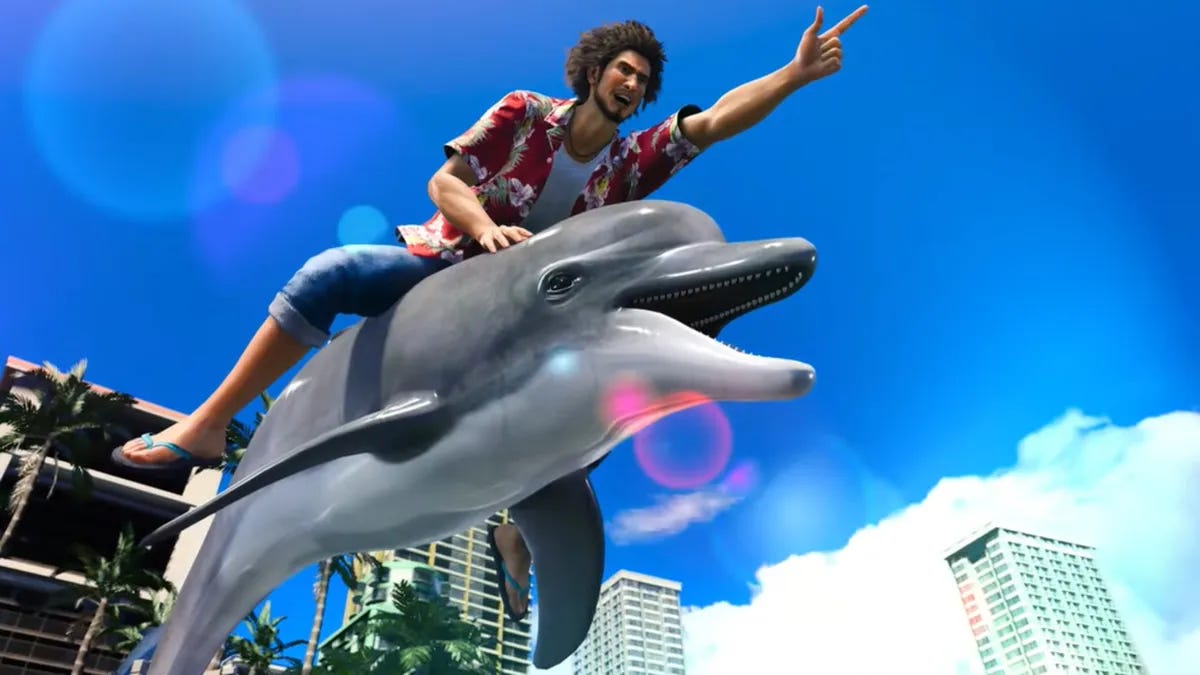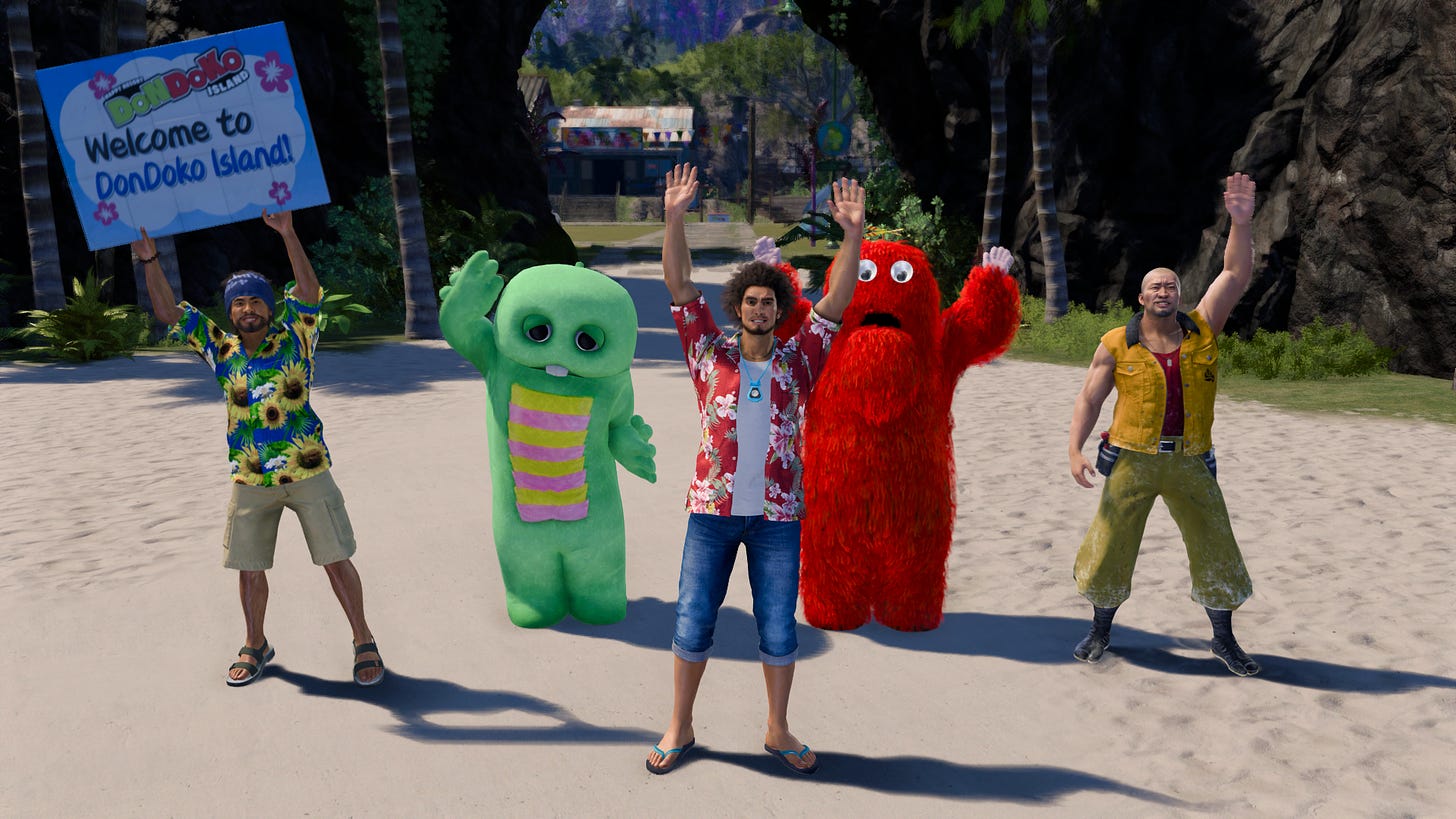This newsletter is brought to you by long-time Indian journalist Karan Pradhan who recently branched out from mainline media to start his own newsletter, The Qun which you should definitely subscribe to for interesting opinion-driven games coverage coming soon.
To say that the ninth mainline game in the Yakuza/Like a Dragon series carried a massive burden of expectation would be an understatement. Ever since its announcement at the 2022 Tokyo Game Show, the hype around Like a Dragon: Infinite Wealth has been steadily snowballing. Until January 26, that is — when all the promotion would be forced to take a backseat to the actual game.
Over a month on, I’ve spent 86 or so hours on the game as part of my first playthrough. During this time, I’ve experienced the main quest, the myriad weird and wonderful substories, the Animal Crossing-inspired Dondoko Island management sim, the Pokémon-lite Sujimon League, the whole host of minigames and all the dramatic twists and turns of the narrative. I find myself of the opinion that while the game was good value for all the hype, said hype (perhaps by design) did not cover what I believe to be the best aspect of Infinite Wealth. But we’ll get to that shortly.
A whole new world
The first thing I notice every time I fire up a new Yakuza/Like a Dragon game is how comfortingly familiar the world seems. For the record, I played the game on Xbox Series X and PC — an Alienware Aurora R15 (with an NVIDIA GeForce RTX 4090 GPU and an i9-13900KF processor). In terms of looks and performance, apart from the improved frame rate on PC and superior load times on Xbox, I found the experiences to be quite similar.
Now with most games in this series, I take a few minutes to reacquaint myself with my surroundings before jumping into the story. Of course, ‘surroundings’ is far too inadequate a word to describe the various locations you encounter in these games, seeing as how they’re key characters themselves. Over the course of various titles in the franchise, certain locations in cities come to life with activities and story beats, while others lie dormant — and so while it’s largely the same area, its personality evolves.
On that note, you kick things off in Infinite Wealth amidst the comforting familiarity of Isezaki Ijincho (a ficitionalised district of Yokohama that was first featured in 2020’s Yakuza: Like a Dragon). Very shortly after, however, comes the franchise’s very first foray outside Japanese shores — a version of Honolulu, Hawaii. And as the subhead suggests, it’s completely different to anything you’ve seen in the series thus far.
Signs bearing the Roman alphabet, American store chains, ne'er-do-wells threatening to sue you… in English, and the sort of automobiles you see driving on the right-hand side of the road are just the tip of the iceberg. Over time you’ll notice the rather more sprawling nature of this new map — the clearly differentiated commercial and residential areas, the plush hotels, the stunningly rendered beach, the array of ‘shave ice’ stalls, and so on.
As the newest entrant in the roster — that hitherto included districts of Tokyo, Osaka, Yokohama, Okinawa, Fukuoka, Sapporo, and Nagoya — the personality-filled Honolulu certainly makes its mark as a memorable character in the franchise. Not to mention, a fantastic location for this latest chapter in the series.
A tale of two dragons
A majority of the pre-release hype focused on the sort of shenanigans you could expect while playing as Kasuga Ichiban (the new face of the franchise unveiled in the previous game). A relatively smaller percentage of the fanfare was lavished on Kiryu Kazuma, the series’ original protagonist over seven mainline titles and countless spinoffs.
And it’s with good reason, because while the premise for Kiryu’s tale had been laid out in the pre-release promotional materials, the details had been kept under wraps. And before we begin to unwrap these details, I should probably issue a warning that mild spoilers will follow.
Ryu Ga Gotoku Studio — the developer of the Yakuza/Like a Dragon series — is no stranger to juggling multiple narratives. It may be recalled that 2015’s Yakuza 5 saw five stories being told simultaneously. Telling Ichiban and Kiryu’s entwined stories, therefore, is nothing special. However, it is the manner in which this is done that is most impressive. Ichiban finds himself in the sort of story that has become a series trademark — the aftermath of an event uncovers a conspiracy that expands and goes all the way to the top.
Kiryu, on the other hand, has been diagnosed with cancer. The once-mighty fourth chairman of the Tojo Clan (Japan’s then-largest yakuza group) who battled armies of foes singlehandedly, is now forced to rely on the help of friends new and old. He embarks on an emotionally-charged farewell tour of sorts to make peace with his past, alongside tackling the challenges of the day. It is the telling of his story that not only is the most sparkling diamond in the crown of Infinite Wealth, but instantly turns the game into a must-play.
Let me be clear: This is not a mawkish departure from his character filled with group hugs and campfire sessions singing ‘Kumbaya’. Kiryu remains as stoic as ever, but only just so slightly more willing to break down that tough exterior long enough for a solitary tear to slip through. The journey taken by lone wolf of yore Kiryu to discover that it is from friendship that one gains the titular infinite wealth is a testament to the studio’s marvellous writing chops.
The bottom line
Infinite Wealth improves upon its predecessor in almost every conceivable way — story, combat, gameplay, world-building, character arcs and side content. However, this is the case with almost every sequel in the world of Yakuza/Like a Dragon. For me, it’s the manner in which Kiryu’s swansong (as it would seem) is handled that elevates Infinite Wealth to the level where it should be spoken of in terms of its ‘Game of the Year’ potential.
In a world that raves over emotional writing (see: The Last of Us Parts I and II), Infinite Wealth stands tall as a work of restraint and balance. Keen readers may recall that in my review of Like a Dragon Gaiden: The Man Who Erased His Name, I’d noted that the demo for Infinite Wealth “was the most encouraging and enjoyable part of the entire package”. I’d like to confirm that the main course more than lived up to the appetiser.
The only problem is that you will really only get your money’s worth (and your tears’ worth of emotional beats) if you’ve played most of the games in the series so far. And that could take a hell of a long time. [9]










